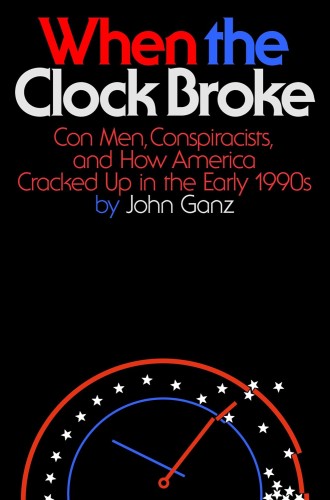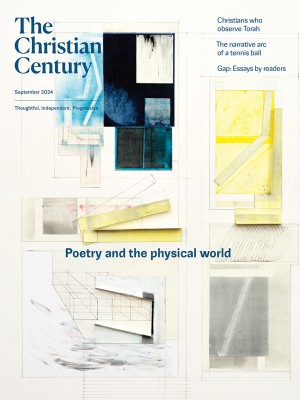What happened to US politics?
John Ganz explores the gritty political and cultural trends that erupted in the early 1990s and set the stage for the present.

When the Clock Broke
Con Men, Conspiracists, and How America Cracked Up in the Early 1990s
During the Trump years (the first ones, at least), I experienced a new political sensation. It wasn’t anger or dismay on policy grounds—I was long accustomed to that. The only word I could apply to it was humiliation at being ruled by such cheap frauds. There have been plenty of dreadful, foolish, and venal people in power, across all the administrations of my lifetime, and plenty of the sort one thinks of as fundamentally decent and yet given, as a professional necessity, to the dissembling that pervades public life. But people with neither talent nor morals, whose skulduggery served no plausible ideological agenda, who did not try to make their lies sound convincing, and who did not even seem to aspire to mediocrity were an unwelcome novelty. How had our republic come to be at the mercy of such buffoonish amateurs?
When the Clock Broke: Con Men, Conspiracists, and How America Cracked Up in the Early 1990s has prompted me to ask instead: Why did it take so long? John Ganz, who tracks the intellectual trends of the current and historical far right in his Unpopular Front newsletter, tells a story of American public life from the last days of the Cold War to the first months of the Clinton presidency, focusing on the cynics, freaks, and losing candidates of the age. This period may appear now as the beginning of America’s unipolar moment of global hegemony and of a long economic expansion. But Ganz takes us beneath the triumphal surface to the gritty and granular political and cultural trends that were gathering under and, with startling frequency, erupting from it. It was the era of David Duke, of Rush Limbaugh and the shock jocks, and of Pat Buchanan; of racially charged local politics and riots in Los Angeles and New York; of militia movements and domestic terrorism; of an eccentric third-party candidate who briefly led in the polls and, after extensive self-sabotage, still finished with almost 19 percent of the vote. It appears, in Ganz’s telling, as an uncanny dress rehearsal for our own period: history repeating, but the first time as farce.
Read our latest issue or browse back issues.
The chief guide through Ganz’s house of horrors is a rather marginal former Senate staffer and right-wing columnist named Sam Francis. When the mainstream of conservative intellectual life sounded the themes of Enlightenment liberalism—favoring free trade, rights-based legal reasoning, and an internationalist orientation in foreign policy—Francis turned to nationalism, searching for a blood-and-soil motif inside the dissonant chorus of American history. He coined the phrase “middle American radicals” for his imagined constituency, people who were threatened economically by the decline of industrial employment, demographically by immigration and Black birth rates, and culturally by a government and leading institutions that ignored or outright scorned their “values.” He didn’t think of himself as a conservative at all but as a revolutionary seeking to radically alter the social order from within.
Francis’s demonically insightful commentary, along with that of fellow eccentric Murray Rothbard, provides the connective tissue between Duke’s stunning appearance in Louisiana and Buchanan’s primary challenge to George H. W. Bush in 1992. Breaking from Republican orthodoxy on trade, immigration, and the cautious acceptance of the civil rights revolution, Duke, Buchanan, and eventually Ross Perot pointed toward a new synthesis that would later come to be called populism. Ganz situates the other stories of the period around this political trajectory, and they are stories that feel eerily familiar today.
Loneliness was an epidemic. No one had yet coined the term incel, but spurned, resentful men found out they could attain the power they lacked in real life by talking on the radio, whose culture of disembodied license presaged the joking rhetorical violence that would flourish online. (Limbaugh was fired from an early DJ gig for playing the Rolling Stones’ misogynistic fantasy “Under My Thumb” too many times.) Declining rural economies provided fertile ground for conspiracy theorists and extremist movements. Police brutality broke out into public view, prompting new calls for accountability and a counterreaction in defense of the impunity and privileges of the “thin blue line.” People disliked and distrusted the major parties and their candidates, so Perot inspired a cult of personality around his nonpolitician persona and his nonspecific policy platform. Faith in civic institutions drooped so low that John Gotti, a tacky and diminished variation on the mob boss type, became a cult hero during his trials for murder and racketeering. Crowds cheered the beating of people protesting a presidential candidate. The far right, starting with Duke, began to embrace Russian nationalism.
Hindsight can always find analogies and precursors for current events. But Ganz is after more than startled recognition. He offers an account of deep continuities in American political and cultural life.
Ganz’s project is part of a growing field of revisionist history of the American Right. Since the 2009 paperback release of Rick Perlstein’s Before the Storm: Barry Goldwater and the Unmaking of the American Consensus, scholars and writers have been looking beyond presidential candidacies and mainstream publications to tell the story of the modern Right, and thus modern America, from the perspective of its obscure intellectuals, movement organizers, and little-known funders. (I encountered Ganz’s thesis about the early ’90s on the podcast Know Your Enemy, an encyclopedic examination of the American Right).
Nixon’s “southern strategy” and the backlash to the gains of the civil rights era were long treated as central to the remaking of American politics between 1964 and 1984 and the breakup of the New Deal coalition that had held sway for the previous 30 years. But by looking at figures who were, or are, one or more rungs below the daily awareness of the liberal intelligentsia, these new histories more fully describe the swirl of trends, anxieties, and transformations that connected intellectuals and grassroots movements to the electoral upheavals of the era. Racial backlash was critical, but it was only one part of a bigger, weirder story of a society losing its bearings and the people offering salvation.
It just so happened that in 1992 one of those people was Bill Clinton, who for all his flaws appears in When the Clock Broke as even more talented than conventional histories remember him. Heir to a series of blowout Democratic defeats, playing a bad hand, and at one point polling in third place, Clinton managed to do enough to accommodate the fear and hostility of the moment to slow the decisive swing of Francis’s middle American radicals to the Republican Party. Clinton’s pandering tactics have long been condemned by liberals. But a world in which Democrats conceded the restive, resentful center of American life to their opponents may well have been worse than what actually followed. Two lopsided victories, a strong economy, and a sustained drop in violent crime took the wind out of Republican populism and set the conditions for Barack Obama to become the first Democrat to win back-to-back popular-vote majorities since FDR.
The political urgency of reading the mood and doing what it takes to win in unfavorable circumstances is one lesson of the early ’90s. But Ganz’s book mostly highlights another: that the shadowed regions of the national psyche are never fully repressed or finally healed. As everything changes, they remain—from the militia movement after the Cold War back to the John Birch Society in the ’50s and early ’60s and the Klan and nativist Black Legion in the ’20s and ’30s—always saying more or less the same things about the same real and imaginary threats to hearth and home, blood and soil, livelihood and prestige. There is always a vast latent audience for their stories, however false their history, irrational their resentments, or fraudulent their cures. And even their own clownishness is not always strong enough to stop them.






